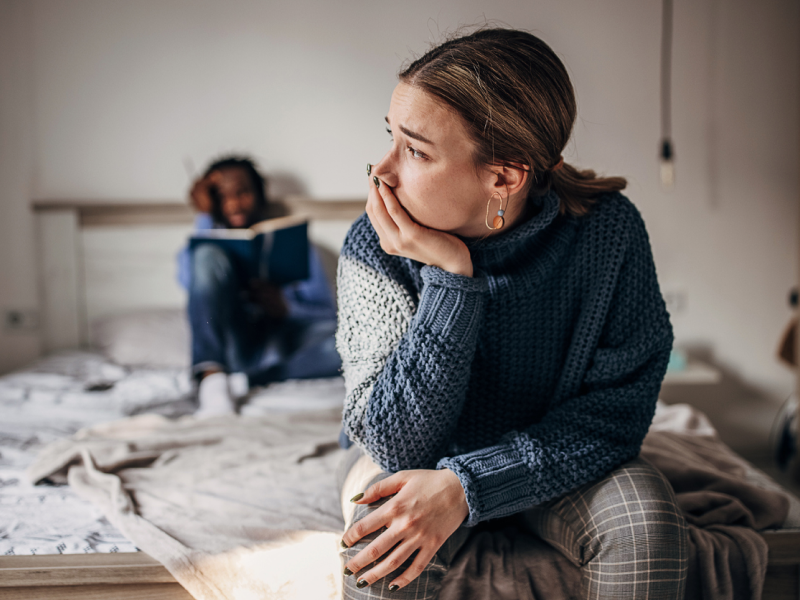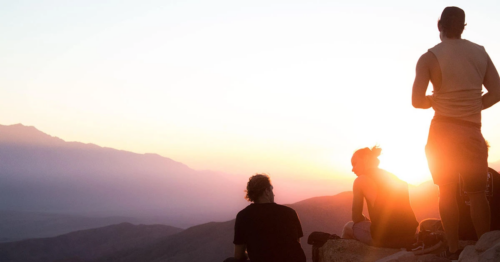
Table of Contents
Signs of an Unhealthy Relationship

Written By: Alex Bachert, MPH

Clinically Reviewed By: Dr. Don Gasparini
Updated: August 7, 2023
7 min.
Everyone deserves to be in a healthy relationship, but teen dating violence is more common than you may think. Learn how to spot the signs of an unhealthy relationship for yourself or others.
Learn more about our Clinical Review Process
Table of Contents
Teen dating violence is a type of intimate partner violence between two young people who are in a relationship or who were formerly together. Dating violence can occur in person or online and comes in many shapes and forms—but it never has a place in a healthy relationship.
Opening up about an unhealthy or abusive relationship can be hard, but is essential for your well-being since studies show dating violence can have serious mental health consequences, including depression, anxiety, and even suicidal thoughts. Everyone deserves to be in a healthy relationship. Here, we’ll discuss how to tell the difference between a healthy and unhealthy relationship and the different categories of abuse that affect teens today. Many kinds of relationships can be unhealthy—including friendships and relationships with colleagues and family members—but this piece focuses on romantic relationships.
Healthy, unhealthy, or abusive?
Signs of a healthy relationship
Healthy relationships are based on trust and honesty. You might not always get along with your partner, and you’ll surely have disagreements, but healthy relationships have a foundation of mutual respect. Partners in a healthy relationship make decisions together—whether it be where to eat, who to hang out with, or choices around intimacy. Partners in healthy relationships look forward to seeing each other between classes or after work, but are also content to have lives independent of one another. Signs of a healthy relationship include:
- Respect
- Good communication
- Trust
- Honesty
- Equality
Signs of an unhealthy relationship
Unhealthy relationships, on the other hand, are defined by one person’s attempts to control the other. Instead of having an open conversation about sex, someone in an unhealthy relationship might try to pressure their partner into sex. Instead of understanding the healthy balance between time together and time apart, someone in an unhealthy relationship will try to control their partner’s time. In an unhealthy relationship, a person will demand everything without offering the same respect in return. Signs of an unhealthy relationship include:
- Poor communication
- Distrust
- Disrespect
- Isolation
- Dishonesty
Signs of an abusive relationship
Abusive relationships have the same problems as unhealthy relationships, but they take the issue of control to another level. Abusive individuals don’t respect their partner’s thoughts, feelings, or safety and often refuse to engage in healthy communication. Signs of an abusive relationship include:
- Control issues
- Hurtful, insulting, or demeaning communication
- Inconsistent behavior
- Blame shifting, gaslighting
- Isolation
- Manipulation or pressure
- Physical violence
Healthy relationship
Unhealthy relationship
Abusive relationship
In a healthy relationship, there’s trust, open communication, and mutual respect. Partners can make decisions together and maintain their independence.
An unhealthy relationship involves poor communication and disrespect, with one person pressuring their partner and trying to control them.
Abusive relationships are controlling to the point of danger, possibly including harmful communication, blame-shifting, isolation, manipulation, and even physical violence.
Am I in an unhealthy relationship?
Data from the Centers for Disease Control and Prevention says that approximately 1 in 12 high schoolers experienced physical dating violence, and 1 in 12 experienced sexual dating violence in 2019. So how do you know if this means you?
No relationship is always perfect (and that’s ok!), but a good rule of thumb is that healthy relationships make you feel good about yourself, and unhealthy relationships don’t. If you find yourself feeling controlled, isolated, or even scared in your partnership, that’s a sign that it might be an unhealthy relationship. Still unsure if you or a friend is in an unhealthy relationship? Take this quiz from Love Is Respect, a non-profit dedicated to education and advocacy around healthy relationships.

We support survivors.
Trauma-informed care with people who have been there too.
Six types of relationship abuse
When we hear the term “abuse,” we might think of physical violence, but there are actually multiple ways to intimidate your partner. Whether it’s physical abuse, emotional abuse, or financial abuse, the driving force behind all kinds of abuse is one person’s desire to gain power and control over another. There’s no one specific behavior that marks a relationship as abusive, and sometimes these behaviors start small and grow over time, but there are clear signs of abuse to know about. Below we’ll review six of the most common types of relationship abuse.
1. Physical abuse
Each year, nearly 1.5 million high school students are physically abused by their romantic partners, according to a CDC report from 2003. To break that down a bit more, this means that 1 in 10 high school students has been purposefully hit, slapped, or physically assaulted by someone they’re in a romantic relationship with.
While some types of abuse can be difficult to recognize, there’s no mistaking someone’s meaning when they use physical force to hurt or attempt to hurt someone else. Signs of physical abuse include:
- Hitting, pushing, punching, slapping, or shoving
- Spitting
- Pinching
- Choking or strangling
- Pulling your hair
- Locking you out of a house or car
- Abandoning you in dangerous places
- Preventing you from eating or sleeping
2. Sexual abuse
Sexual abuse is forcing or attempting to force a partner to engage in a sexual act when they don’t consent, are unable to consent, or downright refuse. This also includes non-physical sexual behaviors like sharing sexual messages or photos from a partner without their consent. Signs of sexual abuse include:
- Any unwanted sexual act, including kissing
- Demanding sex or something sexual against your will or without your consent
- Rape or sexual assault
- Refusing to practice safe sex
- Stopping you from using birth control or a condom
- Withholding sex as a form of control
- Pressuring you into sex at a time or in a place you’re not comfortable with
- Giving you drugs or alcohol before sex
3. Psychological abuse
Psychological abuse is any sort of verbal or non-verbal communication that’s intended to control or emotionally harm a partner. Research suggests that rates of emotional and psychological abuse are actually higher than physical violence among teens, with approximately 76 percent having reported emotional or psychological abuse during relationships.
Another analysis from the 2001 National Longitudinal Study of Adolescent Health found that 20 to 30% of young people reported being verbally or psychologically abused in the previous year. Of those who reported abuse, 6 percent were insulted; 23 percent were sworn at, and 4 percent were threatened by a partner. Signs of emotional and psychological abuse include:
- Isolating you from family and friends
- Insulting you or putting you down
- Picking fights, screaming, or calling you names to the point where you feel like you need to alter your behavior to avoid upsetting your partner
- Attacking your vulnerabilities, such as your education, physical appearance, mental health status, or other insecurities
- Withholding approval or affection as punishment
- Creating a sense of dependency by claiming they can’t live without you or threatening to do something drastic if you leave
4. Stalking
Stalking is defined as a pattern of unwanted attention from a current or former partner that’s intimidating enough to cause safety concerns. It’s more than someone lurking outside of your locker or driving past your office, and it’s actually more common than you might think. Approximately 3.5 million women and 1 million men had their first stalking experience before they turned 18, according to the Stalking Prevention, Awareness, and Resource Center. Most stalkers pursue their targets at least once per week, and often use multiple methods. Signs of stalking include:
- Following someone
- Memorizing your schedule and showing up where you are
- Sending unwanted or excessive gifts
- Sending unwanted texts, photos, emails, and messages
- Tracking what you do online or who you call or text
- Damaging or threatening your property
5. Digital abuse
Digital dating abuse is essentially emotional abuse that’s done on the internet. Most abusers use texting or social media to harass, stalk, or intimidate a partner. Signs of digital abuse include:
- Controlling who you can and can’t be friends with on social media
- Using social media or any other technology to track your activities
- Insulting or humiliating you online with posts, photos, or videos
- Sending you negative, insulting, or threatening messages
- Pressuring you to send explicit photos or compromising messages
- Pressuring you to share your account passwords
6. Financial abuse
A recent study found that 31 percent of U.S. teens have reported being on the receiving end of financial abuse from a romantic partner. Signs of financial abuse include:
- Preventing you from having or keeping a job
- Harassing you at work
- Making you ask for money
- Taking your money
- Not allowing you to discuss money with others
- Making fun of your financial contribution by saying it’s not worth anything
Relationship support at Charlie Health
Being in an abusive relationship can lead to anxiety, depression, and even suicidal thoughts. If you think you may be in an unhealthy or abusive relationship, Charlie Health is here to help. Our virtual intensive outpatient program (IOP) combines supported groups with individual and family therapy to create a personalized treatment plan for people needing more than once-weekly mental health—including those recovering from an unhealthy or abusive relationship. Fill out this short form to get started today.




